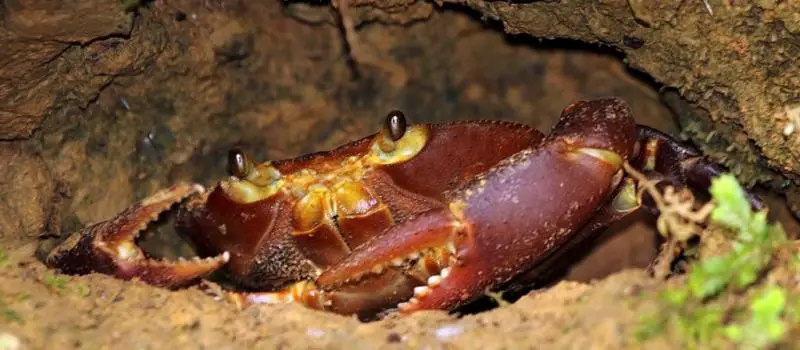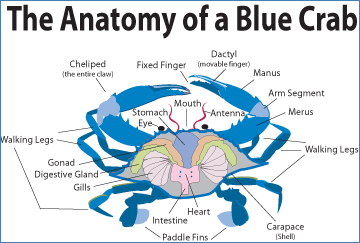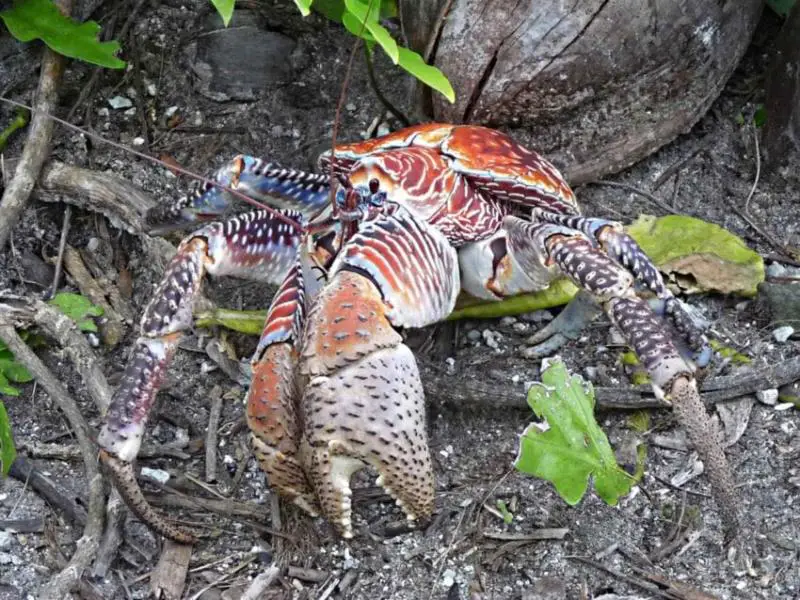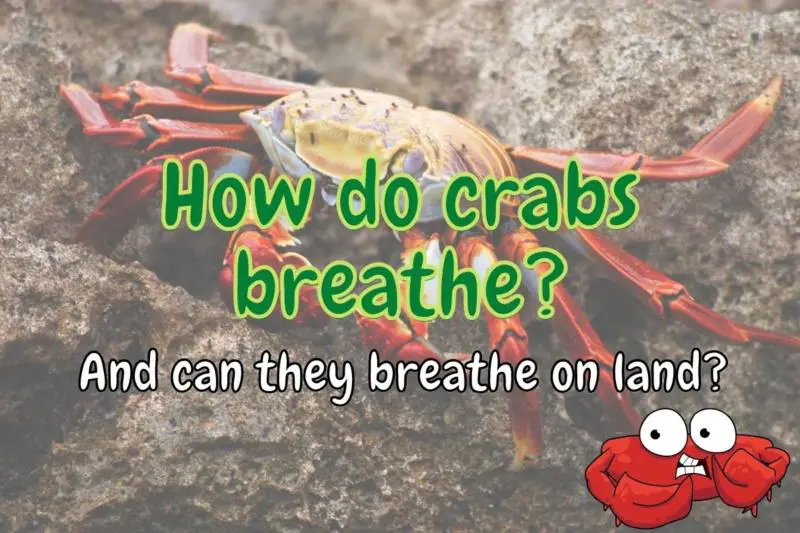Different crab species have different ways of breathing to suit their habitat. Some crabs live in water, others on land. Additionally, many crabs spend a large proportion of their time underground.
The blue land crab (not to be confused with the blue crab, which is water-adapted) can move seamlessly between water and land. On the other hand, the blue crab cannot survive long periods outside of water whereas the coconut crab will drown if submerged in water for too long.
Crabs use gills, just like fish, to breathe underwater. However, most fish cannot breathe outside of water, but crabs can. This is because the gills of crabs do not collapse and stick together outside of water, reducing so that the surface area and its ability to absorb oxygen stays intact until it dries out.
Crabs have reinforced gills that do not collapse or stick together outside of water. These reinforcements are like the reinforcements of a tent, keeping it from collapsing.
Crabs can store water in their gill chambers to help them breathe during short periods away from water.
Long-term adaptations to living on land include specialized gill chamber linings that can absorb oxygen. Surprisingly, the Manicou crab, also known as the mountain crab, has lung-like structures to breathe air. Each crab is perfectly adapted to their environment.

Contents
How do crabs breathe underwater?
Crabs have two gill chambers on either side of their body. Water enters their gill chambers from openings at the bases of their legs and leaves through openings near their mouth 2.
Crabs have small respiratory appendages that work like paddles to move water through their gill chambers and over their gills. Their gills then absorb oxygen from the water.
The blue crab is specialized for aquatic life and can only survive about 24 to 48 hours outside water, probably because their gills are not as rigid as those of land-adapted crabs2.

How do crabs breathe on land?
Crabs can store water in their gill chambers to keep their gills moist while they are on land3. Many air-breathing crabs live close to water to regularly replace the water in their gill chamber 4.
They can recirculate the water over their gills or bubble air through the water to replenish the oxygen supply of the water in their gill chamber 3.
This method is often used for short periods outside water. For longer periods outside the water, crabs need to breathe air.
Can crabs breathe air?
Land-adapted crabs, such as the coconut crab 1, 3, and the black-backed land crab 2, can breathe air through their gills without the need for water in their gill chamber. Additionally, these crabs can absorb oxygen through their gill chamber lining 2, 3.
Their gill chamber lining contains extensive folds to increase its surface area and has an increased blood supply to transport oxygen to the rest of the body3.
Their respiratory appendages are still active when they are in the water, but when they are on land, the walls of their gill chambers make slow pumping movements to suck in air 4, 5, similar to the breathing movements we humans make to suck air into our lungs.
This complete adaptation of crustaceans to land is only seen in crabs. For example, shrimp, crayfish, and lobsters do not have the ability to breathe on land for extended periods of time.

The mountain crab has respiratory structures connected to their gill chamber that are more similar to human lungs than they are to gills5. Air from the gill chamber enters these lung-like structures through various openings in the gill lining5.
By using their lung-like structures, their gill chamber lining, and their gills to breathe with, they can survive in water, on land, and in burrows3.
How long can a crab hold its breath?
Marine crabs can stay from a few hours to several days on land without suffocating, whereas terrestrial crabs like the coconut crab will drown in a matter of hours of being immersed in water in their adult state!
Because crabs do not have lungs, they cannot “hold” the water that they breathe. Rather, their ability to breathe outside of water depends on the water absorbed in their gills.
When they go out of the water the time which they can “hold their breath” depends on how fast their gills dry out, which depends on the humidity, temperature, species of crab etc.
Can crabs drown?
It might sound surprising, but crabs can indeed drown!
Land-adapted crabs still have gills to absorb oxygen from water, but the rigid shape that prevents them from collapsing in air, results in a smaller surface area that cannot extract sufficient oxygen from water – leading to drowning if submerged for too long!
For example, the black-backed land crab cannot survive 18 hours in water2. Other crabs, such as the blue land crab and the shore crab can breathe equally well on land or in water2.
Drowning is essentially the lack of sufficient oxygen in the water.
Crabs can also suffocate in small amounts of water (such as in a bucket) where oxygen is used up quickly. It is better to transport crabs in air rather than in small amounts of water. Even water-adapted crabs can survive longer outside of water than they can in a small container of water with limited oxygen.
How do crabs breathe under the sand?
Many crabs hide in burrows or bury themselves in the sand to hide from predators. Studying crabs inside their burrows is difficult, so we don’t know that much about how they breathe while underground.
We do know that how they breathe while underground depends on how deep they are, how long they remain there, and whether they are surrounded by air or water while underground.
The deeper the burrow, the less oxygen is available, however, crabs are well-adapted to these conditions and can spend hours to months in their burrows 6.
Crabs are usually inactive inside their burrows, therefore they need less oxygen compared to when they are active. This is not much different from animals that hibernate like groundhogs that spend the whole winter inside their burrows.
Crabs that bury themselves in the sand don’t have a problem with low oxygen levels, since they remain close to the surface. Instead, they face the challenge of keeping their respiratory openings unblocked while surrounded by sand.
Most crabs only bury themselves for short lengths of time to hide from predators and can hold their breath 7.

For longer periods underground, crabs reverse their breathing by drawing water in through the opening near their mouth and pushing water out through the openings near the bases of their legs to prevent sand from clogging their respiratory system7.
This method of breathing is often used by crabs that spend most of their time buried and only emerge to look for food.
Most crabs bury themselves with a backward movement until only the front edge of their shell and their eyes stick out of the ground, allowing them to breathe as usual.
The masked crab, circular crab, and shame-faced crab, however, can bury themselves completely for several hours7.
The masked crab and the circular crab form a breathing tube with their two antennae that stick out of the sand while they are burried7.
Others, like the shame-faced crab, form channels between their tucked-in pincers and their shell to draw water into their gill chamber while they are buried7.
Conclusions
When it comes to breathing, crabs are fascinating creatures representing a diverse repertoire and versatility in their adaptations to different environments.
While the breathing organs of most aquatic crabs resemble that of other water animals such as fish, some crabs have respiratory organs in between aquatic and terrestrial animals.
This intermediate between gills and lungs of e.g. the Trinidad mountain crab is a fascinating example of how aquatic animals adapted to a life on land.
Lobsters are another interesting example of shellfish with an extreme oxygen tolerance. But for these crustaceans, it is all in the efficient oxygen transportation system of their blood!
I have also written about how octopi, squids, and crayfish breathe under (and above) water so check out those posts if you’re interested!
Sources:
- Schmidt-Nielsen K. 1997. Animal Physiology. Cambridge University Press, New York, NY, USA.
- O’Mahoney PM, Full RJ. 1984. Respiration of crabs in air and water. Comparative Biochemistry and Physiology. 79 (2): 275-282.
- Innes AJ and Taylor EW. 1986. The evolution of air-breathing in crustaceans: A functional analysis of branchial, cutaneous and pulmonary gas exchange.
- Taylor EW and Innes AJ. 1988. A functional analysis of the shift from gill- to lung-breathing during the evolution of land crabs (Crustacea, Decapoda). Biological Journal of the Linnean Society, 34: 229-247.
- Innes AJ, Taylor EW and El Haj AJ. 1987. Air-breathing in the Trinidad mountain crab: A quantum leap in the evolution of the invertebrate lung? Comparative Biochemistry and Physiology, 87A (1): 1-8.
- Pinder AW and Smits AW. 1993. The burrow microhabitat of the land crab Cardisoma guanhumi: Respiratory/ionic conditions and physiological responses of crabs to hypercapnia. Physiological Zoology, 66 (2): 216-236.
- Bellwood O. 2002. The occurrence, mechanics and significance of burying behaviour in crabs (Crustacea: Brachyura). Journal of Natural History, 36 (10): 1223-1238. http://dx.doi.org/10.1080/00222930110048891




